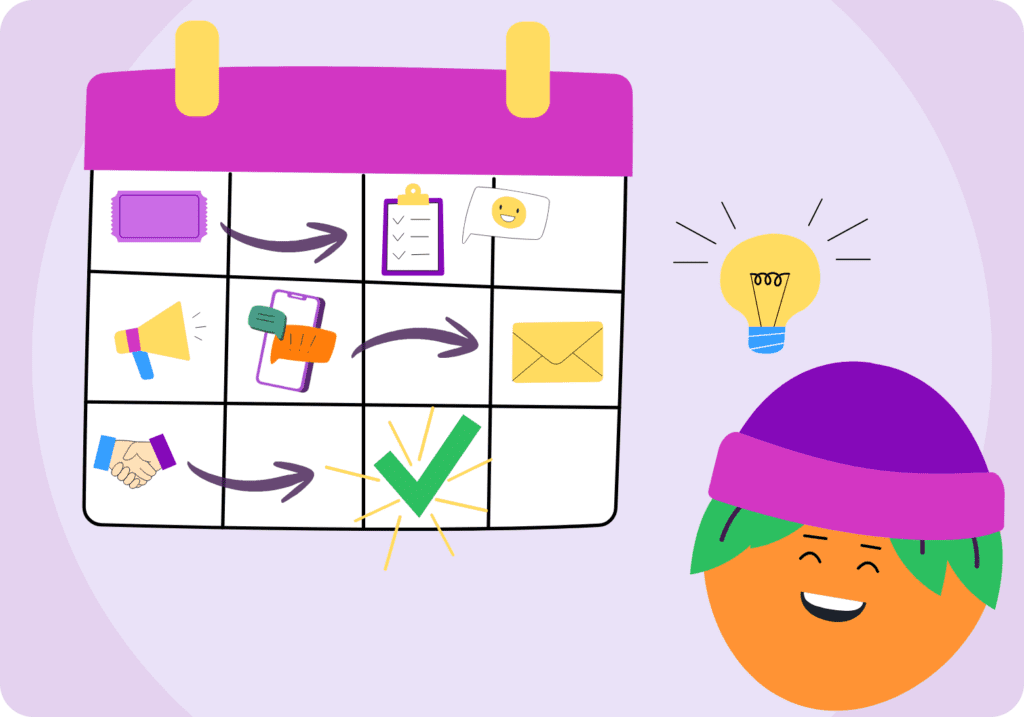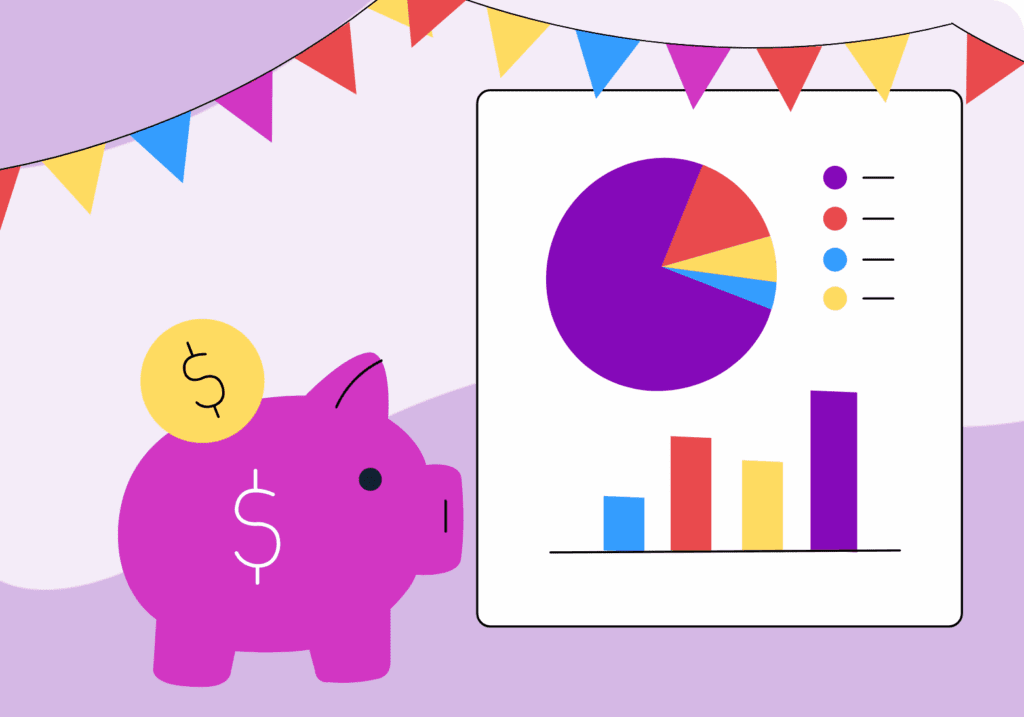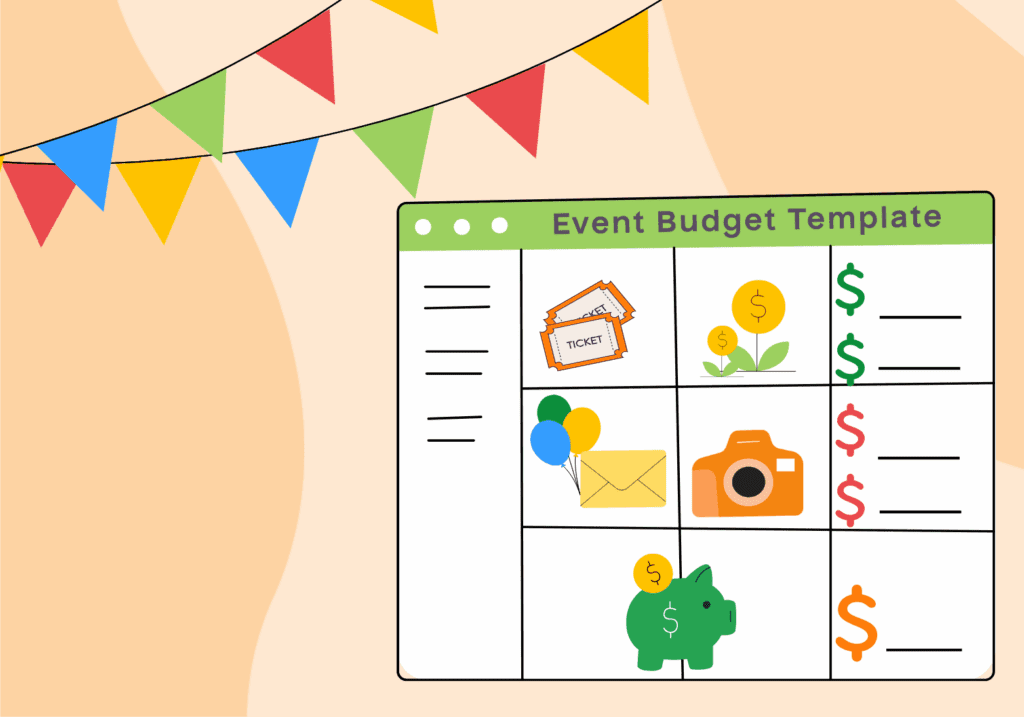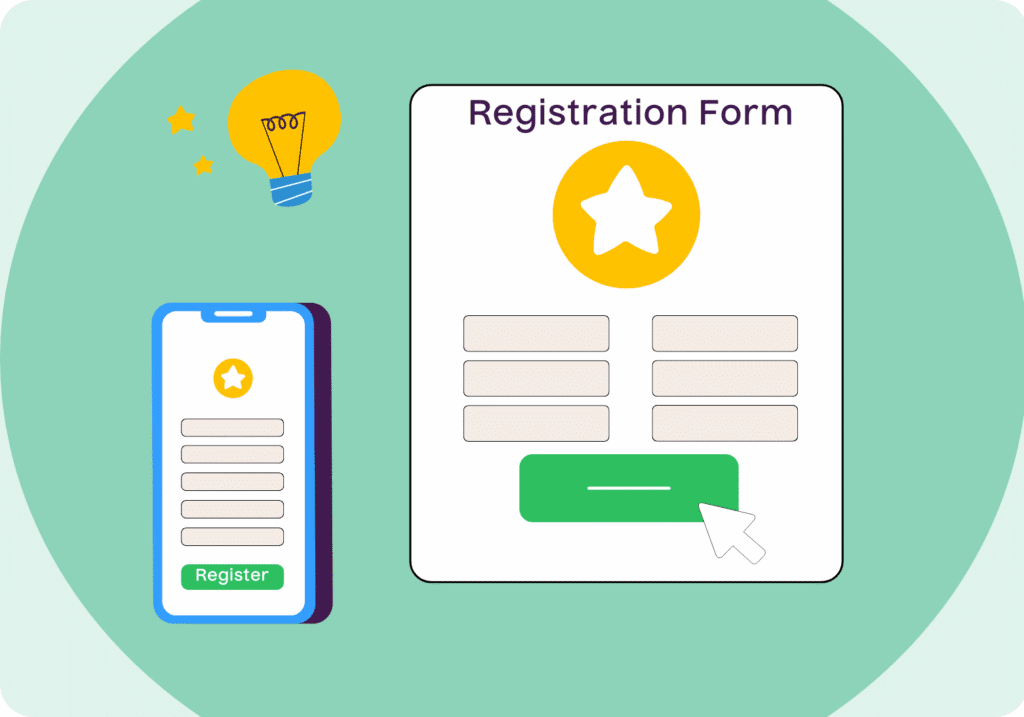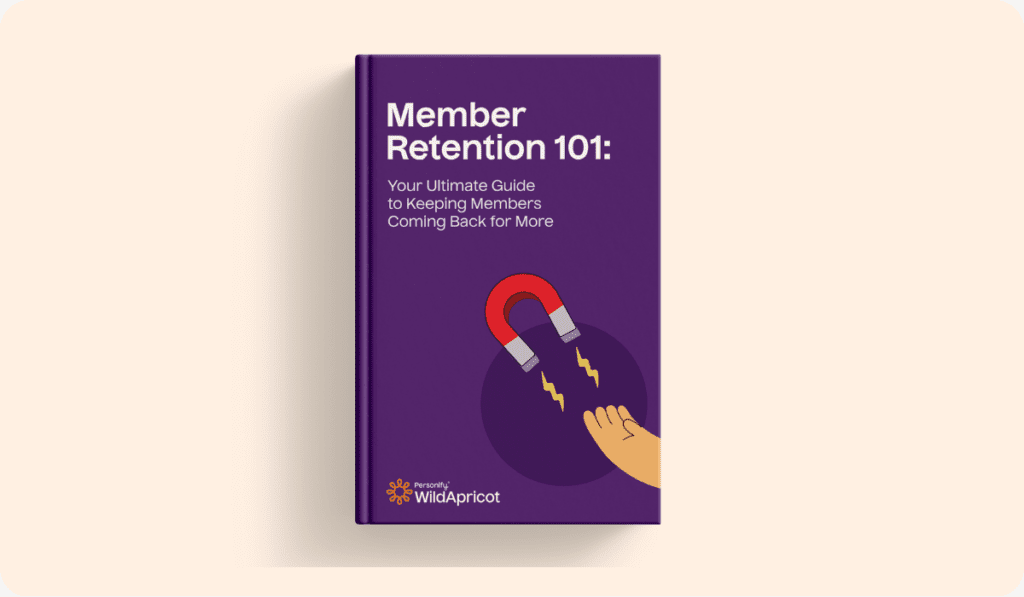If you’re considering hosting a conference, we say go for it — it’s an amazing way to offer professional development to your community, provide them with networking opportunities and grow your own presence in your industry.
Every successful conference starts with a well-thought out plan. That’s why in today’s post, we’ll be going over everything you need to know to plan your best conference. From finding a venue to hosting your post-mortem meeting, we’ll cover every step.
Looking for a checklist you can use for your conference planning?
Download our FREE conference planning checklist here.
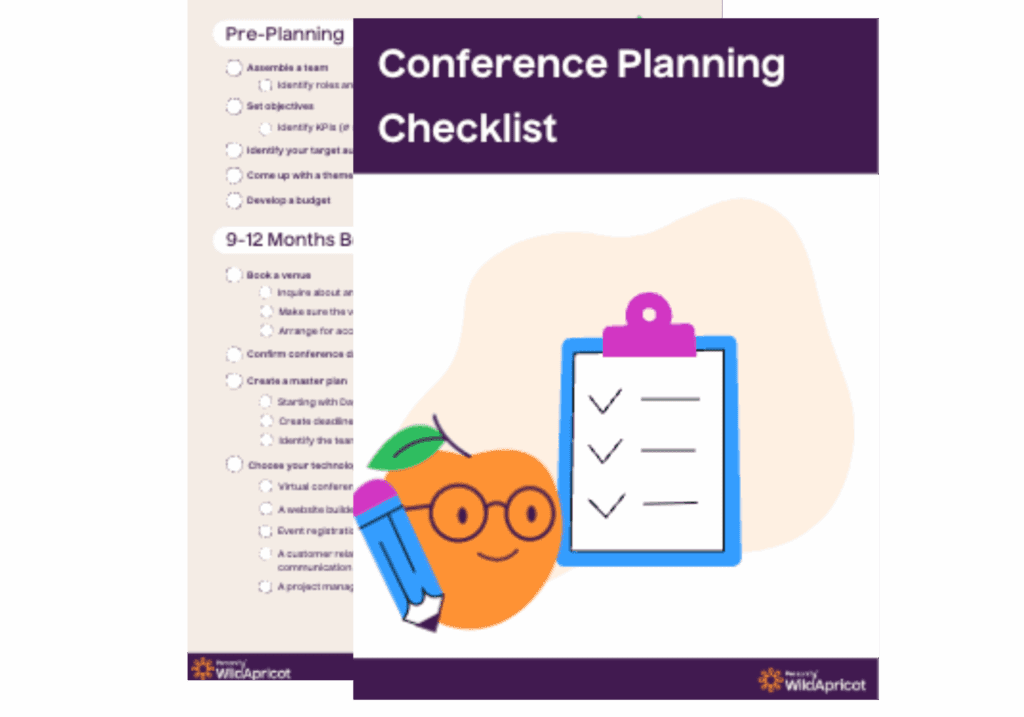
What’s a Good Conference Plan?
A good conference plan is detailed, yet highly organized and easy to follow. It includes clear goals, milestones and timelines for achieving them. It covers everything you need to do before, during and after the conference.
Most importantly, creating a conference plan is not a one-and-done activity — it’s a collaborative effort that needs to be regularly reviewed and updated as necessary to have successful events.
Before You Start Planning
Before you actually start planning your conference, there are a few essential decisions you need to make and tasks you need to complete:
1. Assemble a Team
Who will be involved in organizing this conference? Who will be responsible for what? If you don’t have enough staff members who can dedicate their time to planning this conference, can you assemble a volunteer committee?
2. Set Objectives
What are you hoping to achieve with this conference? How many attendees, new contacts, or new members are you hoping to gain? How much revenue are you looking to generate?
Utilize the SMART goal framework (specific, measurable, attainable, relevant and time-bound) and identify KPIs (key performance indicators) to help you evaluate the success of your conference.
3. Identify Your Target Audience
Who is this conference for? Who would be interested in attending and what would they gain from it? Answering these questions will help you better promote your conference and attract the right kind of ticket buyers.
4. Come Up With a Theme and Format
Your conference doesn’t necessarily have to have a theme but it can help you tie everything together and put on a cohesive event. Your theme can be seasonal, related to a current trend, or the general landscape within your industry.
Also think about the format of your conference. Will it be in-person, virtual, or hybrid? How many days will it last and how many sessions will you offer?
Read more: 12 Fundraising Metrics Your Nonprofit Needs to Track
5. Develop a Budget
How much money do you have to spend on this conference? Will you be looking to offset some of your costs with sponsorships? Where can you save money and where do you need to spend a bit more? (For example, a great keynote speaker will be well worth the cost.)
How To Keep Your Team Motivated When Planning a Conference
Planning a conference is a big undertaking and can often last an entire year. Your planning committee might feel overwhelmed, stressed, or even burned out by the process. Here are a few tips to help make sure that doesn’t happen:
- Give everyone clear jobs and set expectations
- Set lots of manageable mini-goals and assign mini-tasks
- Regularly remind your team about your mission and vision, as well as your objectives for this conference
- Share wins and celebrate even the smallest achievements in the planning process
- Maintain open communication and make sure your team knows that they can ask for help and guidance at any time
17 Steps for Planning a Successful Conference:
Your Conference Planning Checklist
Now, without further ado, let’s take a look at the 17 steps you need to take to plan a successful conference. These are roughly broken down by when they should be completed. Use this checklist as a guide, but ultimately, your own timeline will depend on the size and format of your conference, as well as the size of your team.
Let’s dive in!
9-12 Months Before the Conference
1. Book a Venue
If you’re organizing an in-person or hybrid conference, finding a venue should be your number one priority. Start with the venue and select your conference dates based on its availability, as opposed to the other way around. This will guarantee you’ll find something that fits your goals and vision for the conference.
When looking for a venue, consider the following:
- The size of your conference (How many attendees do you expect?)
- The format of your event (How many sessions will be happening at the same time? How many rooms will you need? Where will attendees have a chance to network with each other?)
- Your conference’s theme (If possible, find a venue that reflects it.)
When booking a venue, be sure to inquire about any additional fees and regulations, accessibility, and possible accommodation for out-of-town attendees.
2. Confirm Date(s)
Once you’ve selected a venue, work with them to finalize the date(s) of your conference. Do this as soon as possible, as you’ll need to share this date to everyone involved in the next steps.
3. Create a Master Plan
Starting with Day 1 of the conference, work backwards and list every single task that needs to be done, its deadline, and who’s responsible for completing it. Use this checklist as a starting point and fill it with more details — no task is too small to be included in the master plan. Share this plan with everyone involved, refer to it regularly, and update it as necessary.
4. Choose Your Technology
If your conference will be virtual or hybrid, you’ll definitely need a conference platform — this is where your virtual guests will attend sessions and engage with you and each other.
Regardless of the type of conference you’re organizing, you’ll also need a few other tools, such as:
- A website builder
- Event registration software
- A customer relationship management (CRM) system, where you will keep track of your attendees and communicate with them
- A project management tool for keeping track of deadlines, speakers, vendors, budget, etc.
6-9 Months Before the Conference
5. Find Speakers
Inspiring and knowledgeable speakers are in high demand, so reach out to them as early as you can. Great speakers will help you promote your conference and attract more attendees. And it’s not just because people are eager to learn from them, but because everyone wants an opportunity to network with them.
Look for experts in your industry, your organization’s own network, or your local connections. If you need help, the National Speaker’s Bureau is a good place to start.
Read More: The 6 Best Ways to Find a Speaker for Your Association Events
6. Find Sponsors and Exhibitors
Hosting a conference is an expensive undertaking, and finding a sponsor (or a few) can really help keep costs down. Plus, people are more likely to attend a conference if it’s backed by a well-known and trusted company.
For the sponsor, it’s a great opportunity to act on their values, get their brand in front of new audiences, and attract new customers. This mutually beneficial partnership can be the start of a long term relationship, with many more future opportunities for collaboration.
When reaching out to potential sponsors, be sure to look for companies whose values align with yours and who support your mission and vision.
You may also wish to open up your conference to exhibitors — these are companies who’ll pay a fee or offer you their services in exchange for permission to set up a booth and engage with your attendees.
Read More: How to Get Sponsorships: The Complete Guide
7. Develop Branding
Branding affects how potential ticket buyers will feel when they come across information about your conference. It includes things like your conference name, slogan, logo, color palette, messaging and imagery. In order to attract attendees, these things need to be unique, cohesive, and inspiring.
Take time to brainstorm ideas based on your conference’s theme and your goals. You may need to hire a photographer and graphic designer to help you create graphics and other brand elements. You’ll use these on your website, invitations, tickets, event program, and all promotional materials.
Read More: The Ultimate Guide to Nonprofit Branding
3-6 Months Before the Conference
8. Order Branded Merchandise
Conference attendees love free stuff and most will expect to receive a swag bag of some sort. When choosing which swag items to order, opt for things related to your industry and that your guests will actually use. Order them as soon as your brand elements have been finalized — that’s the best way to save money and reduce pre-conference stress.
Don’t forget to also ask your sponsor(s) if they’d like to include any promotional items in the swag bags.
At this point, you can also order t-shirts for volunteers, lanyards and name badges, signage, and other branded event materials.
9. Find Suppliers
Some event venues will provide internal employees to take care of things like catering, security, furniture, A/V, and Wi-Fi. If not, you’ll need to hire external suppliers and get permission from the venue to bring them in. Find and book them early to make sure they’re available on the dates of your conference.
10. Recruit Volunteers
Figure out how much support you’ll need during the conference with things like:
- Parking
- Coat check
- Attendee check-in
- Wayfinding
- Managing speakers
- Managing exhibitors
- Set-up and tear-down
Recruiting volunteers for these and other small tasks will ensure that your conference runs smoothly and that your guests have a positive experience.
To find volunteers, look within your organization’s existing community, advertise at your local post-secondary programs related to your industry, and post open positions on your website and social media.
Be sure to recruit more volunteers than you anticipate needing, as some of them will likely drop off in the days leading up to the conference.
Read More: How to Recruit Volunteers from Start to Finish
11. Start Promoting
Set up a website and a registration page so people can start buying tickets. About two months before the conference, you can start advertising early bird pricing.
Promote the conference on your website, in your emails, and on social media. Send out a press release and try to get media coverage in local papers and on the radio. Consider paying for digital and social media ads that target your ideal audience. And don’t forget to offer special deals, giveaways, and registration prizes to entice more people to attend.
Read More: 5 Tips For Getting Your Event Message Out
1 Month Before the Conference
12. Finalize Conference Schedule
At this point, all your speakers and events should be finalized, so it’s time to create your conference schedule. For the attendees, create a program that will be handed out at the start of the event. Make this program available digitally, as well.
For everyone else — speakers, your staff, venue staff, suppliers, and volunteers — create a master schedule that’s easy to follow and has all the necessary details. Be sure to include contact information of key persons who would need to be notified should anything go wrong.
13. Finalize Tasks With the Team, Volunteers, Speakers and Venue
In addition to receiving a master schedule, everyone involved behind-the-scenes needs to receive a customized document that outlines their key tasks and responsibilities. This will help ensure that everyone knows what’s expected of them, where they need to be and when, and what they need to do to make sure the conference runs smoothly.
1 Week Before the Conference
14. Send Out Reminders and Check-In
Send out email reminders to all attendees. Publish an FAQ on your website and offer your contact information should they have any questions or concerns.
Check in with your team, speakers, and volunteers — make sure everyone feels ready and has everything they need before the big day.
1 Day Before the Conference
15. Last Team Check-In and Kick Off
The day before the event, check in with the team once again to see how everyone is doing, address any final concerns, or communicate any last minute changes.
During the Conference
16. Conference Management
As the conference organizer, you shouldn’t have any actual tasks during the entire duration of the conference, other than being available for your team should they run into any issues.
If you’re hosting a hybrid conference, a dedicated team should be live-streaming the events and engaging with virtual attendees.
Someone who’s responsible for communications at your organization should be monitoring engagement at the event and on social media. If your conference is a multi-day event, they can also send out daily recaps via email to help attendees remember the highlights and transition into the next day.
After the Conference
17. Follow-Up and Analysis
Congratulate yourself for hosting a successful conference! However, the work isn’t done yet. Here are a few things you need to do to wrap up:
- Send a follow-up email to all attendees to thank them for attending and invite them to complete a survey.
- Follow up with sponsors, speakers, and volunteers to thank them for their help.
- Analyze attendance numbers, revenue, engagement rate, and other metrics to see whether or not you met your goals.
- Host a post-mortem meeting with your team to discuss what went well and what you would do better next time.
- Keep in touch with all attendees to remind them about any other upcoming events, services, membership, etc.
Make Conference Planning Easy
Conference planning involves many moving parts, particularly on the technology side — you need to build a website, create a registration page, process payments, track attendees in a CRM, and send them regular updates and reminders.
Of course, you can look for separate tools that will take care of each of these tasks, but that can get very expensive and very tedious, especially if the different tools don’t integrate with each other.
A much better option would be to invest in an all-in-one solution like membership management software. It’s a single tool that can take care of all of the aforementioned tasks and help you save hours of manual work (not to mention, unnecessary expenses).
Here at WildApricot, we’re proud to be the number one rated membership management software on the market. We regularly help nonprofits plan and execute events, as well as engage with their communities well after the event is over.
If you’re curious to learn more, start a free 60 day trial and see if WildApricot is for you.
Best of luck with your conference!





